Moisture And Condensation - Metal Roofing Products Help Manage The Inevitable
By Marge O'Connor, DesignandBuildwithMetal.com
Moisture condensation is common where humidity and temperature fluctuations occur outside and when conditions or activities inside a building create moisture. Plus, the current emphasis on creating more energy efficient or more airtight buildings can
actually trap moisture inside the building. Left untreated, unwanted moisture can damage wood and cause corrosion of metal decking, roof panels and fasteners in the roof structure.
Although all roofing materials can be subject to condensation, a benefit of metal roofing over other materials is that metal doesn’t absorb moisture. No matter the roofing material, preventing or minimizing condensation can be achieved with careful
design of a building’s roof system including the use of vapor retarders, insulation, ventilation, or moisture barriers.
What’s the best method of condensation control? The choice depends on the type of building, its location, and design of the roof structure. Several options may be available depending on the project. To help evaluate solutions, we asked some experts
in condensation control products to offer their different views on how to prevent or resolve the issue.
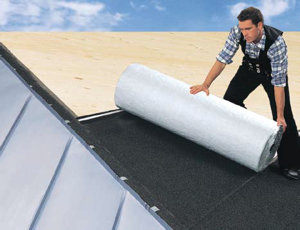
| |
Moisture control materials such as RoofAquaGuard 3D offers an easy application that can quickly be applied directly to the roof deck prior to installation of the metal roof panels. Click image to enlarge.
|  |
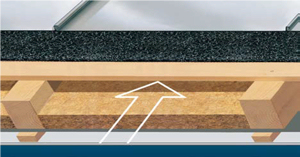 | |
Environmental building regulations have increased air tightness with a consequent increase in the risk of condensation. Adequate ventilation is essential to controlling condensation in buildings. Creating a space between the deck and the
standing seam roof or architectural panels allows airflow that helps remove moisture.Click image to enlarge.
| |
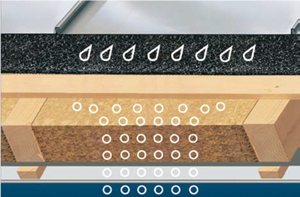 | |
Underlayments and breathable membranes have become an important component in roofing. Breathable synthetic underlayments allow moisture to dissipate through the membrane as long as there is a space between the deck and the roofing. Click
image to enlarge.To learn more about RoofAquaGuard products visit www.roofaquaguard.com. | |
David Nemes, President of Nemco Industries, Inc., West Vancouver, BC, Canada, noted that lack of adequate air space is a typical problem. ”With metal roofing, the most common installation methods in terms of selection and installation of
underlayment is skipping the purlins and placing the metal right on the deck. That is not recommended should condensation, or moisture be present. When you put on a metal standing seam roof, or architectural panels, you need to create a space between
the deck and metal panels to allow airflow to remove the moisture. You also need to install spacers close enough so you don’t have oil canning, and to eliminate problems if someone needs to walk on the metal sheathing.”
Nemco Industries is the North American marketing and sales arm for Sweden-based Nordic Waterproofing Co. Ltd., which also has manufacturing plants in Denmark, Finland and Sweden.
Nemes says he was the first to bring European manufactured synthetic roofing underlayment to North America in the 1990s. “Now there are about 54 different brand names of underlayment in the market and four generations of underlayment - saturated
felt, nail down, breathable and 3D breathable. Altogether the brands might have about 10 to 20 percent of the market share for underlayment,” he says. The product he currently distributes is the nail down RoofAquaGuard UDLX.
Nemes suggests that breathable synthetic underlayment will allow moisture to dissipate through the membrane and rid the building of moisture from within as long as there is a space between the deck and the roofing.
“The choice of breathable underlayment goes hand in hand with the amount of space created between the deck and underlayment. Without the space, breathable doesn’t make any sense whatever. Breathability means that moisture becomes gaseous and
penetrates material based on the differential between the inside and the outside pressure. Therefore it will not allow moisture to go both ways, as the gaseous moisture will always travel from low to high pressure. The key is the thin breathable film
between the layers of non-woven.”
Breathable underlayment is rated by perm, which is also described as water vapor transmission. “In Europe underlayment is not considered breathable unless it has at least 100 perms. Most breathable underlayments are well above those criteria. RoofAquaGuard
BREA has a rating of 146 perms,” Nemes adds.
He notes that nail-down synthetic roofing underlayments offer a lot of advantages. “They are stronger than saturated felt, which usually breaks down due to UV and does not last more than 15 to 20 years. Synthetic fibers are very strong, UV treated
and last forever. Anyone putting on high-end cladding such as metal roofing would be advised to consider synthetic because of its long life span. Now there is a third-generation underlayment with three-dimensional mesh attached to breathable underlayment,
which eliminates the need for purlins. It’s an all-in-one product called Dry-Tech that we exhibited at METALCON.”
“Putting purlins on the roof is time consuming and sometimes not desirable. This product takes away that step and makes it faster and easier to install. It works for residential and commercial and is more expensive upfront, but if you consider the
manpower and material needed to create space, this comes out the same and can even save money,” Nemes says, noting that these synthetic roofing underlayments have been in Europe since the mid 1980’s without a problem with moisture penetration.
Two other types include: SBS Modified Bitumen, peel-and-stick underlayment that will not allow moisture to penetrate the underlayment; and Anti-Con, which absorbs the same way but is applied to the roofing panel by the manufacturer before it gets into
the field. Both of these types are also sound absorbent up to 8 – 9 decibels.
| |  |
 | Colbond mats are made of three-dimensional materials that offer good airflow. Nylon products are typically used under metal roofs but polypropylene products also fit the requirements for metal. Some three-dimensional mats go over any underlayment
material while other three-dimensional materials are attached on the top of the underlayment. These are usually roll goods that are either breathable or non-breathable.Click image to enlarge. |
| | 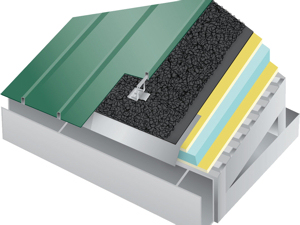 |
| | Colbond’s Enkamat creates an air space between the underside of the metal roof and the secondary weather barrier, which may be composed of either paper or a breathable waterproof membrane. The air space allows natural ventilation
to allow condensation on the underside of the metal roof to evaporate. Click image to enlarge. |
| | 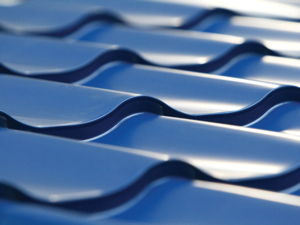 |
| | The flexibility of the Enkamat products allows them to be used in many types of metal roof designs including flat panels and various types of metal tile products. Click image to enlarge.To learn more about Colbond products, visit www.colbond-usa.com. |
Allan Wingfield AIA, Product Manager, Colbond Inc., Enka, NC, offers other solutions. One of his Coldbond’s products, Enkamat, creates an air space between the underside of the metal roof and the secondary weather barrier, which may
be composed of either paper or a breathable waterproof membrane. “The air space allows natural ventilation when there is a vent at the low part of the roof structure and another at the high part of it. This lets any condensation on the underside
of the metal roof evaporate. On a sloped metal roof there is a vent at the bottom to allow air in and natural convection takes air at the top out,” notes Wingfield.
Colbond started out in subsurface drainage and sound control, then moved to roofing and green roofing products. All of its current mats are three-dimensional materials that offer good airflow. “Typically under metal roofs the nylon products are
used but some customers prefer our polypropylene products. Some three-dimensional mats go over any underlayment material. Other three-dimensional materials are attached on the top of the underlayment; these are usually roll goods that are either breathable
or non-breathable.”
These products work best in buildings with any kind of activity that creates moisture or humidity that will eventually find its way into the attic space and the metal roof. In the cooler times of the year when metal is cold the warmer moisture in the
building moves into the attic, hits the metal roof and condenses on the underside. If there’s no air space the moisture never dries out and can lead to premature degradation of the metal roof.
“Our company got into condensation control when we were asked by a zinc manufacturer to help prevent white rust. When moisture forms underneath a zinc roof it can form white rust that if it is not eliminated can eventually damage the roof. Now manufacturers
of zinc roofing have in their standards a requirement to have an air gap layer under the roof,” Wingfield says.
He also noted that Colbond’s condensation control product is an energy saving device because it prevents heat gain in the warmer climates or times of the year. Some of its thinner three-dimensional mats will reduce heat gain by 23 degrees; thicker
ones can reduce it by at least 40 degrees.
“Our products are used all over the country wherever there are temperature swings. With outside air that is cooler than the building temperature you’ll have condensation and some situations may be more difficult than others. A product like
this does multiple things. It also does some sound control because it acts as a resilient break between the metal and the roof, which is a concern in certain types of buildings, such as churches and schools, when there’s a big downpour.”
Enkamat is also used for sound control in roofing and Colbond’s other sound control products are used to keep sound from traveling between different levels inside of buildings. The Enkamat product also helps control both airborne noise and impact
noise such as the sound of rain on the roof.
As far as condensation being affected by the need to design buildings for greater energy efficiency, Wingfield says: “We’re seeing more interest and more demand for both. People are looking for more effective ways to control what happens in
the building envelope. A similar type product is used with rainscreens to allow drying of any moisture that gets in behind the wall. But the highest use is with metal roofing. Actually in all types of roofing you can get incidental moisture when there
is a hard driving rain. This effectively gives it a way to drain out and dry so the moisture doesn’t ultimately go in and cause a leak or cause the material to rot.”
Colbond also make three-dimensional mats for green or vegetative roofs and other related products. “We partner with companies that market products to specific construction or industrial related customers. So our products are used in roof underlayment,
rainscreens sound control, mortar catching devices, vegetative roof drainage, and subsurface drainage around athletic fields. Our products may be used as a carrier for plants, or seed for pre-vegetation prior to assembly on the green roof,”
he adds.
In addition to working anywhere there’s a need to move air or water or dry out the inside of a building, Colbond’s products have some resiliency and are used for sound control.
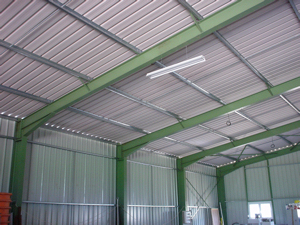 | |
Products such as CondenStop help control condensation through the use of highly absorbent fleece that is adhered to the interior side of steel roof panels.Components including ridge caps, interior gutters and other parts that are prone
to cause condensation problems can also be covered with CondenStop. Click image to enlarge. | | |
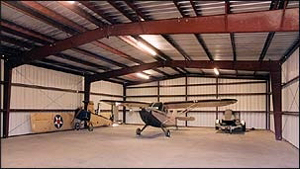
|  |
In steel buildings with large open spaces that are not climate controlled, such as self-storage, agriculture, and airplane hangars, the best moisture control solution is layered synthetic fleece adhered directly to the steel panels. The
breathable material keeps moist air from migrating to the steel. | |
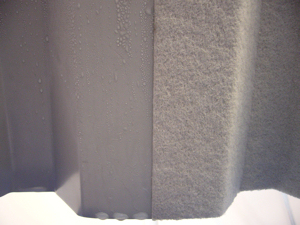 | |
Highly absorbent fleece that is adhered to the interior side of metal panels by the panel manufacturer can control condensation in new and retrofit applications. This example uses CondenStop on the right as a control measure. Without the
covering, condensation remains a problem as shown on the left side. Click image to enlarge.To learn more about CondenStop fleece, visit www.condenstop.com. |
| |
Marcel Konijn, Sales Manager Construction, Lantor/CondenStop, Netherlands, adds another perspective. “With our product we are not trying to prevent condensation but to control it through the use of very highly absorbent fleece that is adhered
to the interior side of the steel panels at the panel manufacturer’s site. CondenStop is delivered with an applied hot melt adhesive and a release foil protecting it. The foil is removed before roll forming and the steel is corrugated together
with the fleece product. The final product can be used in new and retrofit projects. Components like ridge caps, interior gutters and other parts that are prone to cause condensation problems can be covered with CondenStop too. Applications where
this product fits are self-storage, agriculture, or any steel buildings with large open spaces.”
The company entered the U.S. market in about 2009 with one distributor. The company has chosen a local approach to the market through its U.S. representative and now has a roll forming company in Indiana supplying and selling CondenStop. The fleece for
the product is manufactured in the Netherlands and distributed throughout the United States from the Indiana location. “Our product will be part of the metal panel manufacturer’s end product so the CondenStop brand might be known or it
may be branded with the roofing panel manufacturer’s label. Either way, we support our customers with training and with workshops for contractors.”
CondenStop is delivered in coils of 2100 square feet with a diameter of about 40 inches. “The metal panel manufacturer has to add a step in the production process, but it is fairly easy to do and we help them with it. A major benefit of having the
CondenStop applied in the manufacturing process is that it means faster installation time in the field. Customers who have tried the product say they can get more jobs done in a shorter time,” Konijn notes.
The product works well in locations where the climate is humid and there are a lot of temperature swings - the conditions that make condensation occur. Hot, dry climates or areas where temperature swings are minimal are not key markets.
“Most of the time our product is used in open framed buildings. When you have a standing seam roof placed directly on underlayment there is no space between so our product won’t work there. Ours is a breathable product that has a very
open structure and a high absorption capacity. Many people think breathable means from one side through to the other. Ours is adhered directly to the steel so you don’t have moist air migrating through our fleece through the steel. It’s
only one way breathable and needs a ventilated envelope with circulation. It works ideally with above sheathing ventilation when you have a ceiling with spray-on insulation and an open space or attic,” Konijn says.
Buildings where this product is used are not climate controlled. “When you have a climate-controlled building there is not much use for our product unless it is a retrofit where the old roof stays and CondenStop is put under the new roof so that
condensation will not form. Our product also works well with solar energy when a new roof metal roof is placed on top of an existing one,” he adds.
The product uses layered synthetic non-woven fleece with unique Thermoplastic Microspheres. The fibers are soaked and during the curing process they expand to create high-density fiber. The very large internal surface (up to 60 SF per SF of fleece) and
the distribution of large and small pores create the critical characteristics for the effective prevention of sweating and dripping of metal roofs. When condensation occurs, the CondenStop fleece absorbs, stores and re-releases significant quantities
of condensed moisture.
When the temperature of a metal roof drops below the dew point, the CondenStop fleece will absorb and store the condensing water vapor. The absorbed water will evaporate again to the ambient air under appropriate temperature and ventilation conditions.